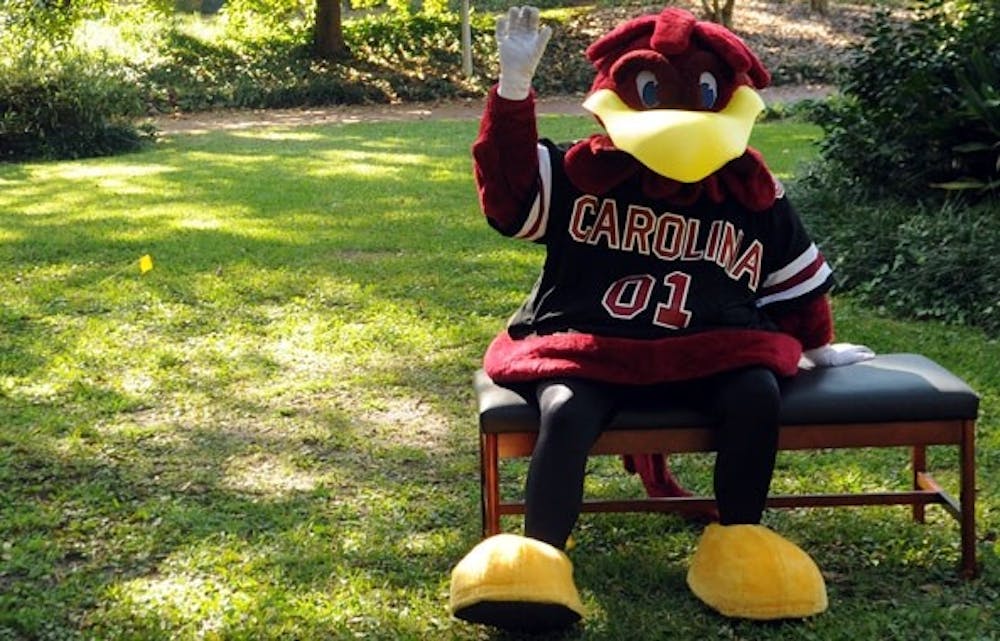The handful of students who take on Cocky’s character are only given a few suggestions about how to portray the character before the role is left up to their discretion.
These individuals are then allowed to build upon and develop the persona of USC’s most energetic bird with their own personalities.
Cocky is one character, but currently, three students help bring the mascot alive at athletic events. Cocky also works with the Cocky’s Reading Express and can be booked for private or community events in Columbia and the area.
With one of these students graduating in May and another graduating in December, USC’s spirit program found two new individuals during tryouts on April 21.
The tryouts were a three-part trial that helped determine whether or not contenders were capable of holding the unique position.
“The tryout process is basically calculated to assess who is capable of bringing the persona alive, being creative and innovative both using everyday objects as props and just engaging an audience, engaging a crowd,” said James Armstrong, a representative of the USC spirit program.
Two of the tryout sessions involved the student-athletes in character as Cocky, while the third part was a brief interview.
“Cocky doesn’t talk, but the person who portrays the Cocky will be having those person-to-person interactions before and after events,” Armstrong said.
Five students attended the tryouts. For most student organizations hosting recruitment, this may seem like a small number, but the spirit program thought it was perfect.
The Cocky tryouts are not typically advertised. Last year, the spirit program went outside the box and put a vague post on social media.
But the program is certain that the people who are the best fit to assist Cocky’s persona will find out about them.
“Those individuals will go above and beyond to find those opportunities,” Armstrong said.
For the first time this year, the two senior Cocky representatives hosted USC’s first high school mascot clinic, which program representatives hope will become an annual event. There were 12 participants, including two who participated in the tryout process.
The clinic was beneficial to the spirit program as whole, Armstrong said, and it added to the quality of the students who want to form Cocky’s persona and assist with fundraising and community outreach.
The newly recruited students will need to consider the mascot’s past before they take on the job of helping maintain the persona in the future.
Jamie Ballentine, one of the most remembered Cockys, won the Capital One Mascot Bowl in 2003 and went on to be a professional mascot.
“I think it’s important to reflect on the past of Cocky. Every new bird that comes in, there’s a few stories that they’ve shared, and they’re directed to watch Jamie Ballentine’s portrayal of Cocky,” Armstrong said. “He kind of set the bar high just because he was so visible nationally.”
Cocky first appeared in 1980, when he replaced Sir Big Spur. But he was not well-liked initially and was booed off the football field.
After attending other sporting events, Cocky began to build a following that set the standard for what the mascot is today.
Yet Armstrong said students who help build Cocky’s persona usually tell him the hardest part is not figuring out the best way to represent the mascot; rather, it is knowing that it’s limited and that they will eventually have to leave the persona behind.
“I don’t think it’s hard to appreciate the moment. It’s hard in knowing that they’re limited,” Armstrong said.
The people who do have the opportunity to assume the persona of Cocky have to keep their role a secret until they graduate. Armstrong said students who have take on the role usually find it difficult that only some close friends know about this important part of their life.
“Separating two lives is hard, but there’s a certain point where they realized that Cocky is more of a part of them,” Armstrong said. “Cocky encourages people to be a better person, both inside and outside of the persona.”

